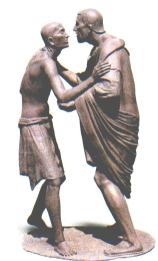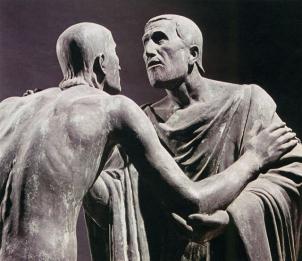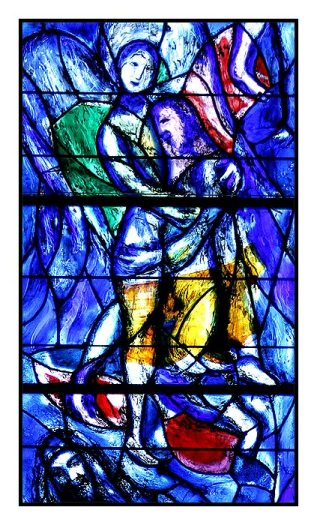May 31, 2005


The
Prodigal
Son
(Opera Pia Jona Ottolenghi - Aqui Terme - Al.)
Roberto Salvini, a
Master of art criticism, speaking of the sculpture by Martini, writes:
The
movement of
the two figures one towards the other, which is represented at the very moment of
its
arrest, the inter – twining of the arms into the beginning of an
embrace, the
sharp and questioning glance of the
father, they are all elements which make the reading of the issue
involved
plane and clear. At the same time, the Roman – style clothes hint at
the
historical timing of the evangelist parable.
However, nothing of all this would be relevant to the value of
the oeuvre
d’art, if it had not been expressed through an individual language,
the
central theme of which is the permeating of the air and the light of
the
plastic surface, the porousness of the material, which seems consumed
by time. In
this way, a dimension of space is created around and inside the
group of
the two images, which are projected into a mythical distance (Guida
all’arte moderna, Garzanti, Milano 1954, p.83 [the translation from
Italian
is mine])
It seems to me,
that nothing can be added to a so brilliant critical assessment.
However… the
sensation is that there is something more in the representation, a
story inside
the story, which does not invalidate the manifest representation, but
that hints
at a more archaic and latent substance: a deeper layer from which the
present
image was engendered.
When I first looked
at the sculpture, I was at a certain distance, and I had not yet read
the title
of the composition.
The primal
sensation, which is always the one that better reconnects to our
unconscious,
was that we are dealing with a scene describing a wrestling. It was as
if the
two men were to hold each other in a Greek – Roman wrestling position,
or they
were two Judo – wrestlers at the beginning of their fight.
Then, coming
closer, I realized that the scene was dealing with an embrace. It was
as if,
under the artist’s fingers, an act of mutual aggression had been
transformed
into a loving thrust.
Only at this point,
I reminded what I had previously written in Rembrandt and the Prodigal Son: under the
Gospels’ overlay, were hidden the mnemonic traces of the youngest son
of the
Primal Horde, who was the vicar of his brothers, and who returned
home in
order to kill the Father. This repressed content was captured at
first by
my unconscious, as it occurs to other visitors.
If we analyze
Salvini’s comment, we find the same traces of the primal event, which
had been
unconsciously captured by the great critic: “ The
movement of the two figures towards each other represented at the very
moment
of its arrest, the inter – twining of the arms into the beginning of an
embrace
[the wrestling], the sharp and questioning glance of the father [as
in the mutual gauging of two wrestlers] they are
all elements which make the reading of the issue involved plane and
clear [at
which level, the manifest of the latent one?]… which seems consumed
by time. In
this way, a dimension of space is created around and inside the group
of the
two images, which are projected into a mythical distance" [= into an archaic
time, which is timeless as prehistoric and psychic events].
Art is one of the
most important instruments for decoding unconscious collective
contents. Those
are transmitted from the artist to the public at the unconscious level,
circumventing
the censoring filter of consciousness. The spectator captures them and
identifies with.
Dealing
with art
Freud wrote: “art offers
substitutive satisfactions
for the oldest and still most deeply felt cultural renunciations, and
for that
reason it serves as nothing else does to reconcile a man to the
sacrifices he
has made on behalf of civilization ("The Future of an
Illusion" (1927), in The Standard Edition of the Complete
Psychological
Works of Sigmund Freud, The Hogarth Press, London 1953, Vol. 21,
p.14).
In the
biblical parable, the central motive of the youngest son
who returns home in order to kill the Father was repressed. The scene
of
reconciliation was overlaid on the act of aggression, according to the
common
proposal of religions. However, the aggressive element, having been
repressed,
pressed for recognition too.
Every
repressed content, which is inhibited from discharging its energies,
accumulates in our psyche, and causes a certain amount of sufferance.
Jacob was left alone, and wrestled with a man there
Theodor Reik, in his essay “The Wrestling of Jacob” (in Dogma and Compulsion,
International Universities Press, New York 1941, pp. 229 – 251),
interprets the biblical story of the wrestling of Jacob as the mnemonic
trace of a puberty rite. In those occasions, the adults of the tribe,
who represent a paternal image and in the biblical myth are represented
by the angel, threaten the youngsters and eventually circumcise them as
a substitute of castration. Reik writes:
As Freud says, civilization demanded instinct renunciation, namely
renunciation
to the aggressive drive towards the
Father, and permitted only the expression of the loving side of the two
– faced
medal of the ambivalent relation between Father and Sons. The result is
the
repression – accumulation of the other side. The artist, introducing in
his Oeuvre
the repressed element, helps the discharge of accumulated energies and
the
subsequent relief.
Marc Chagall and The Wrestling of Jacob (Dec. 5, 2005)
until the breaking of the day...
...The man said, "Let me go, for the day breaks."
Jacob said, "I won't let you go, unless you bless me."
He said to him, "What is your name?" He said, "Jacob."
He said, "Your name will no longer be called 'Jacob,'
but, 'Israel,' for you have fought with God and with men,
and have prevailed." (Gen. 32:24-8)

Chagall’s vitrage in the Fraumunster (Zurich)
Arturo Martini consciously (at the manifest level) expressed the loving
pole of the emotional ambivalence in the father – son relationship, and
unconsciously (at the latent level) released the aggressive element.
The title of his sculpture speaks of love and reconciliation, while, at
the same time, the embrace of love condenses also the aggressive
component of a struggle.
Marc Chagall did the opposite. The title of this scene is “The
Wrestling of Jacob with the Angel”, hinting at an aggressive encounter
between Jacob and the angel, messenger of God and his will doer. Jacob
wrestled with God Himself, as is written: "you have fought with God and with men,
and have prevailed".
God is always a paternal image. The manifest scene speaks of a
struggle between father and son. This time the repressed element is the
loving pole of the emotional ambivalence.
However, the latent unconscious element is pressing for recognition, too.
Staring
at this sublime work of art, we are permeated by a compelling sensation
that we are dealing not with a struggle but with a moving encounter of
love and reconciliation.
we find a reference to the
tradition that Hercules had to engage in such a wrestling contest on
two occasions; once with Hippocroon, when the hero, curiously enough,
suffered an injury to the hip, and once in the Palaestra of Olympia,
when he encountered his father Zeus, who for some time wrestled with
him as an unknown adversary, but finally revealed his identity. Another
observation may perhaps appear more significant: the rabbies declare
that the vein which the God of Jacob injured is identical with the
phallus. The same opinion is maintained in the book of Sohar (Parascha
Wajischlach, p. 170). We venture to suggest that psychoanalysis has
recognized this and other displacements in the myths in question, and
that the symptom of limping has been interpreted as a euphemistic
reference to castration. Now we seem to see the whole episode in a new
light: The god castrates Jacob, or at least attempts to do so. (p.238)…
Therefore, what began as an hostile encounter between Father and Son,
like in the wrestling of Jacob, ends in an embrace of reconciliation,
like in the parable of the prodigal son.
Reik concludes:
… The paternal generation, which after initiation accepts the sons as
equally privileged, now consents to their desires. In the course of
evolution this consent, conditioned by the emotional trend of the
ambivalent attitude, assumes an increasingly prominent position in the
foreground, until the original meaning of the initiation ritual is no
longer perceptible. With the progressive repression of hostile impulses
the paternal affection and care for the young become the central point
of the initiation. (p.240)…
we should regard the words "I will not let thee
go except thou bless me" as the expression of the eternal truth that no
man can enjoy undisturbed happiness in life and love who is still
fighting with the shade of his father. The partial conquest of the
father is, like the reconciliation with him and his
memory, a condition of cultural progress. (p.251)
George Minne: The Prodigal Son
Links:
Rembrandt and the Prodigal Son. On Elder and Youngest Brothers
Pinocchio. The Puberty Rite of a Puppet